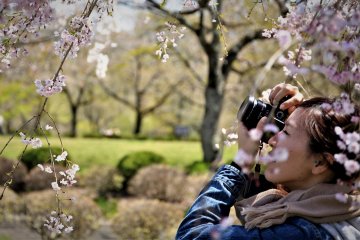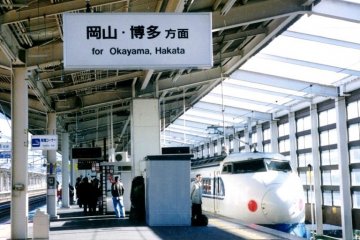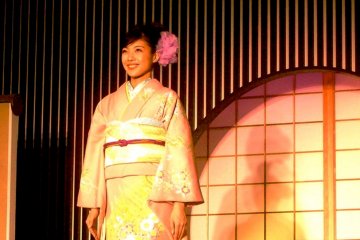The history of Nishijin is the history of Kyoto textiles itself. The word Nishijin comes from the two Japanese words, Nishi, being “West” and Jin being “camp”. At the end of the Onin Wars about 500 years ago, weavers for the Imperial Palace came into this area where the Yamana Sozen, the commander at the time, established the western camp.
A few years ago I bought an antique kimono chest, or tansu from Kyoto. It was over a hundred years old, worn with age, but an heirloom of exquisite beauty that I cannot obtain from the shops anymore these days. It made me wonder about the kimonos that the original owner had stored in the tansu. At the Nishijin Textile Center, there are kimono pattern books from the Meiji period in the late 19th century, showing the symbols of the four seasons, with cherry blossoms and maple leaves in autumn set inside a classical snowflake frame, and a background of summer waves. There are a number of historical displays at this center, including hand looms and old fabric shops from that time. There is also an excellent English and Japanese language exhibit of each step in making Nishijin fabrics, from design, perforation, twisting, reeling, and the use of hand looms. As Nishijin threads are dyed before they are weaved, the thought put into the fabric design is critical in ensuring the artist’s vision is brought to life. You can even watch artisans on site making tomorrow’s masterpieces, or try hand weaving yourself in one of their classes for 1300 yen.
Today, Nishijin, together with Milan and Lyon, are the top three centers in the world for silk fabrics.
If you have a member of your family or traveling group with a passion for dressing up or the art of weaving, the Nishijin Textile Center and museum is sure to please. You can dress up in a genuine Geisha style or 12 layer kimono worn by the imperial court ladies a thousand years ago, and live out your Tale of Genji fantasies for 10,000 yen. Less elaborate kimonos are available for 3,000 yen, or for free, watch a kimono fashion show which runs every hour or so during the day from 10am to 4pm. For everyone else, this is not a must see, but may be worth your while if you are in the neighborhood or on your way to Tondaya Machiya Museum. There is a small cafe in the building, however a short stroll away are some quaint art gallery style cafes.
At times this place is overrun with groups of middle aged package tour bus visitors, especially upstairs where there are various souvenirs for sale, from yukatas to neck ties and other accessories in traditional designs, like lace table runners. It reminded me of some of the Department Stores that I visited when I was a child. However it means that the shop assistants speak reasonable English, especially if you want to buy something. They are never pushy, but it is reassuring that they are there is you need any help.












